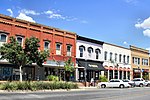Bobcat Ballpark

Bobcat Ballpark is a baseball venue in San Marcos, Texas, on the campus of Texas State University. It is home of the Texas State Bobcats baseball team of the NCAA Division I Sun Belt Conference. It currently holds 2,400 spectators. In 2008, the baseball and softball stadiums were renovated and expanded to its current design. In addition, four luxury suites for up to 12 people were added. The renovations made their debut on March 5, 2009 against the Texas Longhorns with a record setting 2,593 people.Features of the venue include a press box, team merchandise area, batting cages, stadium lighting, and a chain link/mesh backstop.In 2013, the Bobcats ranked 47th among Division I baseball programs in attendance, averaging 1,368 per home game.In addition to Bobcat baseball, the stadium hosts other baseball events, such as high school baseball tournaments. From May 23–26, 2012, it hosted the 2012 Southland Conference baseball tournament, won by UT Arlington.
Excerpt from the Wikipedia article Bobcat Ballpark (License: CC BY-SA 3.0, Authors, Images).Bobcat Ballpark
Charles Austin Drive,
Geographical coordinates (GPS) Address Nearby Places Show on map
Geographical coordinates (GPS)
| Latitude | Longitude |
|---|---|
| N 29.887777777778 ° | E -97.928333333333 ° |
Address
Bobcat Baseball Field
Charles Austin Drive
78666
United States
Open on Google Maps









